Imaging the posterior mediastinum: a multimodality approach
- PMID: 25993732
- PMCID: PMC4498424
- DOI: 10.5152/dir.2014.14467
Imaging the posterior mediastinum: a multimodality approach
Abstract
The posterior mediastinum contains several structures that can produce a wide variety of pathologic conditions. Descending thoracic aorta, esophagus, azygos and hemiazygos veins, thoracic duct, lymph nodes, adipose tissue, and nerves are all located in this anatomical region and can produce diverse abnormalities. Although chest radiography may detect many of these pathologic conditions, computed tomography and magnetic resonance are the imaging modalities of choice for further defining the relationship of posterior mediastinal lesions to neighboring structures and showing specific imaging features that narrow the differential diagnosis. This review emphasizes modality-related answers to morphologic questions, which provide precise diagnostic information.
Figures


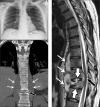
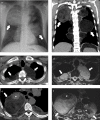
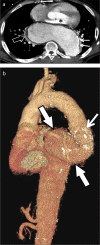



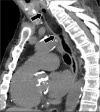



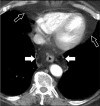



References
-
- Zylak CJ. Diagnostic approach to radiology of the mediastinum. In: Taveras LM, Ferrucci JT, editors. Radiology: diagnosis-imaging-intervention. Philadelphia: Lippincott; 1986.
-
- Reeder LB. Neurogenic tumors of the mediastinum. Semin Thorac Cardiovasc Surg. 2000;12:261–267. http://dx.doi.org/10.1053/stcs.2000.16738. - DOI - PubMed
-
- Strollo DC, Rosado-de-Christenson ML, Jett JR. Primary mediastinal tumors: part II. Tumors of the middle and posterior mediastinum. Chest. 1997;112:1344–1357. http://dx.doi.org/10.1378/chest.112.5.1344. - DOI - PubMed
-
- Kawashima A, Fishman EK, Kuhlman JE, Nixon MS. CT of posterior mediastinal masses. Radiographics. 1991;11:1045–1067. http://dx.doi.org/10.1148/radiographics.11.6.1749849. - DOI - PubMed
-
- Balcombe J, Torigian DA, Kim W, Miller WT., Jr Cross-sectional imaging of paragangliomas of the aortic body and other thoracic branchiomeric paraganglia. AJR Am J Roentgenol. 2007;188:1054–1058. http://dx.doi.org/10.2214/AJR.05.1497. - DOI - PubMed
Publication types
MeSH terms
LinkOut - more resources
Full Text Sources
Other Literature Sources

